Table of Contents
WAEC chemistry practical Questions and Answers 2023
Here is the Waec chemistry practical Questions and Answers 2023
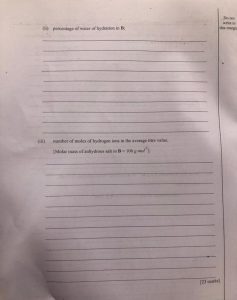
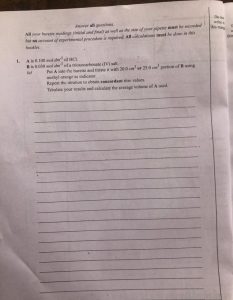
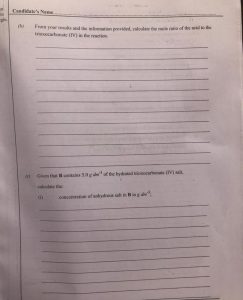
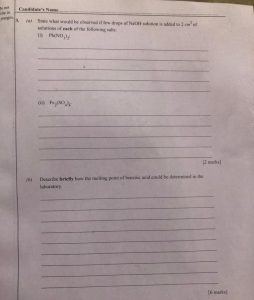
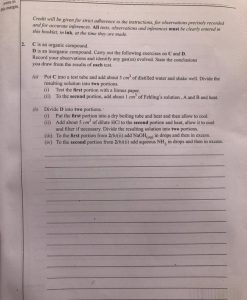
Answers
(2a)
TEST; C + distilled water + shake
OBSERVATIONS; It dissolves to give a colourless or clear solution
INFERENCE; Soluble salt suspected
(2ai)
TEST; Solution C + litmus paper
OBSERVATIONS; It has no effect on both blue and red litmus paper
INFERENCE; Neutral solution
(2aii)
TEST; solution C + Fehling solution A and B + heat
OBSERVATIONS; It gives a black red colour
INFERENCE; Reading agent confirmed
(2bi)
TEST; D + heat
OBSERVATIONS; It turns yellow on heating and white on cooling
INFERENCE; ZnO is present
(2bii)
TEST; D + dilute Hcl + heat
OBSERVATIONS; It dissolves completely to give a clear or colourless solution
INFERENCE; Solution chlorides of Zn³+, Al³+ is present
(2biii)
TEST; Solution D + NaOH in drops and then in excess
OBSERVATIONS; It gives white gelatinous precipitate. The precipitate is soluble in excess.
INFERENCE; Al³+, Zn²+ present.
Al³+, Zn²+ present .
(2biv)
TEST; Solution D + NH3 in drops and then in excess
OBSERVATIONS; It gives white gelatinous precipitate. The precipitate is soluble in excess NH3
INFERENCE; Al³+, Zn²+ is present.
Zn²+ confirmed.
*COMPLETE NUMBER 3*
3a.
When a few drops of NaOH solution are added to a 2 cm³ solution of Pb(NO3)2 (lead nitrate), the following observation would be made:
A white precipitate of lead(II) hydroxide (Pb(OH)2) would form. Lead(II) hydroxide is insoluble in water and appears as a white solid. The reaction can be represented as:
Pb(NO3)2 + 2NaOH -> Pb(OH)2 + 2NaNO3
The formation of a white precipitate indicates the presence of lead(II) ions in the solution, and the reaction between Pb(NO3)2 and NaOH results in the formation of lead(II) hydroxide.
3aii.
When a few drops of NaOH solution are added to a 2 cm³ solution of Fe2(SO4)3 (iron(III) sulfate), the following observation would be made:
A reddish-brown precipitate of iron(III) hydroxide (Fe(OH)3) would form. Iron(III) hydroxide is insoluble in water and appears as a reddish-brown solid. The reaction can be represented as:
Fe2(SO4)3 + 6NaOH -> 2Fe(OH)3 + 3Na2SO4
The formation of a reddish-brown precipitate indicates the presence of iron(III) ions in the solution, and the reaction between Fe2(SO4)3 and NaOH results in the formation of iron(III) hydroxide.
======================
3b
To determine the melting point of benzoic acid in the laboratory, the following procedure can be followed:
1. Obtain a small amount of benzoic acid sample. Ensure that the sample is dry and free from any impurities.
2. Set up a melting point apparatus, such as a melting point apparatus or a capillary tube.
3. Clean and dry a capillary tube, which is a thin glass tube used to hold the sample. Fill the capillary tube with a small amount of powdered benzoic acid, ensuring it is compact and uniform.
4. Insert the capillary tube into the melting point apparatus, making sure it is secure.
5. Gradually heat the melting point apparatus while observing the benzoic acid sample through the magnifying lens.
6. As the temperature rises, observe the sample for any signs of melting. Initially, the powdered benzoic acid will remain solid, but at a specific temperature, the sample will start to melt and form a liquid phase.
7. Note the temperature at which the first signs of melting are observed.
8. Repeat the experiment at least two more times using fresh samples to ensure the accuracy and consistency of the obtained melting point values.
By following this procedure, the melting point of benzoic acid can be determined in the laboratory.
CHEMISTRY SOLUTION
*2A.)*
a) Test for organic compound C:
(i) Litmus paper test:
Observation: The litmus paper remains unchanged.
Conclusion: No significant change in the litmus paper indicates that compound C is likely neutral or non-acidic.
(ii) Fehling’s test:
Observation: No significant reaction or color change occurs upon heating.
Conclusion: The lack of reaction with Fehling’s solution indicates that compound C does not contain a reducing sugar. It suggests that compound C is not a carbohydrate or does not possess aldehyde or ketone functional groups.
(b) Test for inorganic compound D:
Since compound D is an inorganic compound, it may not exhibit the same reactions as organic compounds. Therefore, the tests mentioned in part (a) may not be suitable for compound D. To identify and characterize compound D, different tests specific to inorganic compounds should be conducted based on its known or suspected properties.
==========================
*2B.*
(b) Test for inorganic compound D:
(i) Heating and cooling:
Observation: Upon heating, compound D may undergo a physical change (e.g., melting, sublimation, decomposition) or remain unchanged. After cooling, the appearance and properties of compound D are observed.
Conclusion: The observation after heating and cooling can provide information about the thermal stability, volatility, and physical properties of compound D.
(ii) Addition of dilute HCl and heating:
Observation: If a reaction occurs, such as effervescence (gas evolution) or formation of a precipitate, it indicates a chemical reaction between compound D and HCl.
Conclusion: The reaction with HCl can provide information about the acidic or basic nature of compound D, as well as the possibility of it being a carbonate or bicarbonate.
(iii) Addition of NaOH(aq):
Observation: If a reaction occurs, such as the formation of a precipitate or change in color, it indicates a chemical reaction between compound D and NaOH.
Conclusion: The reaction with NaOH can provide information about the acidic or basic nature of compound D and help identify the presence of certain metal ions or hydroxide compounds.
(iv) Addition of aqueous NH3:
Observation: If a reaction occurs, such as the formation of a precipitate or change in color, it indicates a chemical reaction between compound D and aqueous NH3 (ammonia solution).
Conclusion: The reaction with NH3 can provide information about the acidic or basic nature of compound D and help identify the presence of certain metal ions or complexes.
*COMPLETED*
✅✅
Coming soom, On notifications and refresh in few minutes, also if you want early midnight answers and questions, Please join the whatsapp group from top of the site and chat the admin

I didn’t see number 1 answer
What about no 1
Thanks
Thanks very much